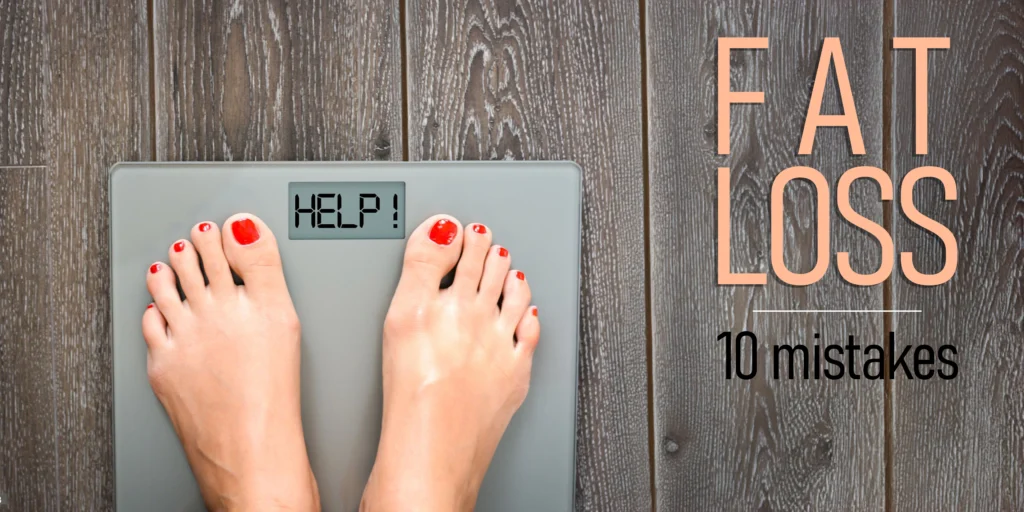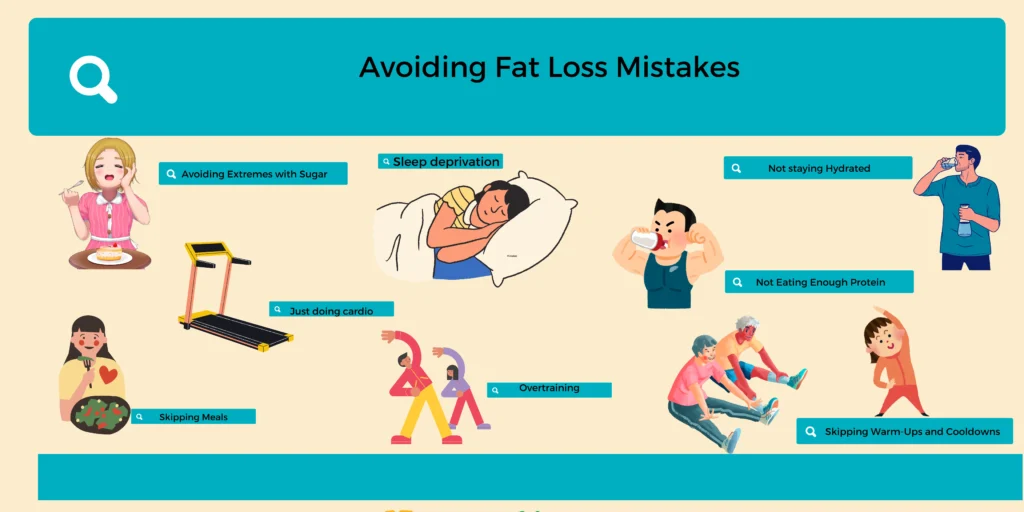10 Most Common Fat Loss Mistakes

Fat loss is one of the major buzz these days among the mob. You can succeed in a weight loss program by avoiding the 10 most common fat loss mistakes. Weight loss can be challenging, and after a promising start, you might feel like you’re making healthy choices but not seeing the desired results. Here are some common mistakes people make when trying to lose fat.
First, let’s clarify: the goal is to burn fat, not just lose weight. Your weight might decrease, but that could mean you’re losing muscle mass, bone density, or just water weight. You must be thinking hey my weight is going down but you have a bigger problem. So weight loss can be alarming and fat loss inspiring.
The 10 most common fat loss mistakes
Losing weight is challenging. Many understand that consuming fewer calories and exercising more can help shed pounds. However, if you feel like you’re doing everything right but aren’t seeing positive results, you might be following misguided advice. Here are some common errors to avoid on your fat loss journey.
1- Skipping meals
Many people cannot differentiate between starving and fasting. According to them, skipping meals will help them lose weight, but this approach can lead to micronutrient deficiencies. These nutrients are crucial for burning excess fat and processing the food you eat. Starvation adversely influences your mood because it deprives your body of the energy it needs to function properly. It slows down your metabolism. This is a common mistake in fat loss.
2- Overlooking the Importance of Consistent Biorhythms in Fasting
In fasting it’s important to follow a circadian rhythm and maintain constant meal timings. For example, starting your fast at 8 AM one day and 2 AM the next can confuse your body’s biorhythms (the natural cycles your body follows). Biorhythms affect everything from your pulse to your heartbeat, and they can be disrupted by changes in daily practice.
Understanding biorhythms is important. Your pulse, heartbeat, and, surprisingly, the vibrations in a room are rhythms. These rhythms can be disrupted by many factors which in turn affect your body’s overall balance and function. Maintaining consistent biorhythms is essential for effective fat loss.
3- Sleep deprivation
Assuming you’re sleep-deprived and attempting to shed pounds. Regardless of how clean your diet is or how much you work out, it won’t be easy to lose weight. We lose fat while we sleep, yet many modern-day professionals claim they don’t have time. Even billionaires, with their busy schedules, find time for important activities. It’s not about having more time; it’s about using the time more effectively.
4- Just doing cardio
The science of fat loss revolves around muscle. Building muscle is crucial, but so are mobility and flexibility. You can get stronger and build muscle, but without flexibility, you might become stiffer. Remember, your spine’s health reflects your youthfulness. Strong individuals who can’t touch their toes may face challenges as they age.
You can develop lean muscles and build strength through activities like squats, push-ups, walking, or playing sports like tennis and cricket. You can do as much yoga as you want. Lean muscle increases your metabolic rate and requires protein transforming your body into a fat-burning machine.
5- Avoiding Extremes with Desserts and Sugar
Individuals who live balanced lives, avoiding extremes are the fittest and happiest. They carry on with healthy lifestyles, avoiding extremes. Many people strive for fitness at the expense of their happiness, becoming overly obsessed. The first ingredient for fat loss, and overall health, is a happy mind. When you are happy, your body gets the message that everything is okay, achieving homeostasis—the body’s natural state of balance and self-repair. On the other hand, if you feel deprived and obsessed with workouts, you create disharmony. This disrupts your biorhythms and prevents your body from functioning optimally, no matter how much you exercise. So maintain healthy fundamentals and enjoy dessert occasionally.

6- Overtraining
If you overtrain, you risk gaining weight due to hormonal imbalances. How can you track this yourself? To monitor overtraining, you should look for signs in your body. Soreness is a key indicator. Some muscle soreness, such as Delayed Onset Muscle Soreness (DOMS), is normal and even good. For instance, if you do bicep curls after a break, your biceps might hurt, but they will become stronger over time. However, if you wake up tired and weary, with persistent muscle pain, it might be a sign of overtraining.
Other signs include needing more food for recovery, frequent injuries, and constant fatigue. Frequent injuries, like sprains, indicate that your workouts might be causing more harm than good. Part of working out is to become stronger, and not to get injured more often. If you’re noticing these signs, it’s crucial to take a step back, ensure you’re getting enough rest, and proper nutrition, and adjust your workout intensity to allow your body to strengthen.
7- Bypassing focus on recovery
Focusing on recovery is essential for achieving and maintaining optimal health and fitness. Recovery allows your muscles to repair, reduces the risk of injuries, and helps prevent burnout. This involves more than just resting; it includes proper nutrition, hydration, sleep, and active recovery techniques such as stretching and low-intensity exercises. By prioritizing recovery, you ensure that your body is ready for the next workout, enhance your performance, and promote long-term well-being. Remember, the time spent recovering is just as important as the time spent training.
8- Skipping Warm-Ups and Cooldowns
Warm-ups prepare your body for exercise by gradually increasing your heart rate, improving blood flow to your muscles, and enhancing flexibility. This reduces the risk of injuries and enhances performance. On the other hand, cooldowns help your body transition back to a resting state, promoting muscle recovery and reducing soreness. They also prevent dizziness and improve relaxation post-exercise. Neglecting these essential components can lead to stiffness, increased injury risk, and prolonged recovery times. Incorporating proper warm-ups and cooldowns into your routine is vital for maintaining a safe and effective workout regimen.
9- Not Eating Enough Protein
Protein helps boost satiety and build muscle mass, aiding in fat loss. Most healthy individuals need at least 0.8 grams of protein per kilogram of body weight daily. For example, if you weigh 60 kg, you need 48 grams of protein a day. This requirement can vary based on factors like age, sex, activity level, and underlying health conditions.
Protein plays a crucial role in body-weight regulation. It is the most satiating macronutrient, helping to curb sugar cravings and prevent excess fat deposits from sugar overloads. Increasing dietary protein, combined with physical activity and an energy-controlled diet, can promote fat loss.
10- Not staying Hydrated
Water makes up over two-thirds of a healthy body and significantly influences body mass and overall weight. Dehydration can reduce fat burning, lead to excessive calorie intake, and slow metabolism. It also reduces energy levels, making it harder to stay active.
Ensuring adequate hydration is crucial. Staying well-hydrated boosts your metabolism curbs hunger, and supports digestion and overall health. Try to drink at least 8-10 glasses of water each day. In hot weather or during physical activity, you may need even more to compensate for fluid loss through sweating.
Conclusion
Achieving and maintaining fat loss requires a balanced and informed approach. By avoiding common mistakes such as overtraining, neglecting recovery, inconsistent fasting, inadequate protein intake, and poor hydration, you can enhance your overall health and reach your fitness goals more effectively. The key to success lies in moderation, consistency, and understanding your body’s needs. Prioritize a happy mind and a balanced lifestyle to turn your body into an efficient fat-burning machine.
Disclaimer: This article is for informational purposes only and is not intended as medical advice. Always consult a healthcare professional before changing your diet, exercise routine, or health regimen. Individual results may vary, and the tips provided may not suit everyone.
Keep posting your inputs, experience, and opinions in the comments section.























